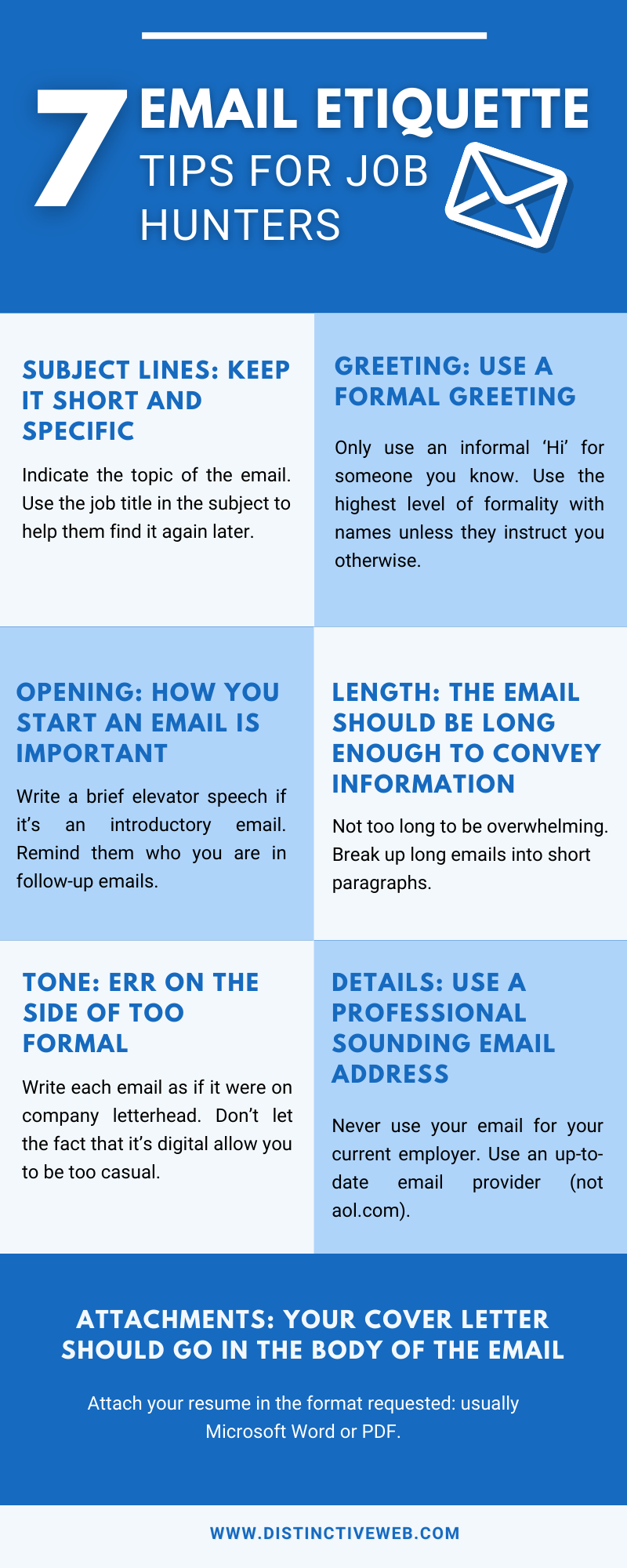
For job seekers in the modern digital age, the search is no longer a face-to-face endeavor but a session of keyboard clicks and screen scrolls.
How you send and handle your “email for job search” can profoundly impact your chances of landing the dream job.
Master the art of email etiquette, steer clear of costly mistakes, and become the candidate that hiring managers can’t resist.
Unleashing the Strength of an Impactful Subject Line
The subject line is your handshake, your first impression. It needs to be specific and concise yet compelling. Picture your recipient scanning their inbox.
Will your email pop out from the crowd? Try including the job title (and job # if relevant) or a mention of a referral.
If you’re not applying for a specific position, highlight your expertise – “IT Security Director with 15 Years of Experience.”
Remember, good subject lines are your ticket to being noticed.
Greetings and Openings: The Heart of Professionalism
Email is a digital letter, not a casual text. Start with “Dear,” “Hello,” “Good morning,” or “Good afternoon.” If you’re connecting with a hiring manager for the first time, avoid a casual “Hi”. Instead, aim for formality; use Mr. or Ms. unless instructed otherwise.
Now, about the opening lines – they are crucial. Introduce yourself effectively, remind the recipient about your previous meeting, or connect on a personal note. But always stay professional.
Your Personal Email Address: Yes, It Matters
If you’re still using that whimsical email address from your college years or relying on outdated email services providers like aol.com or hotmail.com, consider this your wake-up call.
Yes, even your choice of email provider can subtly hint at your age, and in the digital age, you want to show that you’re keeping pace. No room here for ‘beachbum87@email.com’ or ‘gamingmaster@email.com’.
In the professional realm, consider creating a separate email account for your job search activities, ideally a simple variant of your first and last name. Opt for modern, widely-accepted providers like Gmail.
Remember, your professional email address is a reflection of your professional persona. So don’t let an inappropriate or outdated email account cast a shadow over your job search.
It might be a small detail, but it reinforces your overall professional image when done right. So ensure it paints you in the best possible light. You’re not merely a job seeker but a forward-thinking professional looking for new job opportunities!
Don’t Overwhelm: Keep it Simple and Brief
In your job search, the art of simplicity and clarity in your emails is key. Hiring managers often juggle tight schedules and might overlook an excessively lengthy email. Stick to the KISS (Keep It Simple, Searcher) principle.
Focus on the job opportunity at hand and how your skills align with it. Brevity and clear structure are your allies here. Break your content into digestible chunks to enhance readability, highlighting key points, like your qualifications and the specific job opening you’re applying for.
In the whirlwind of job searching, this straightforward approach is an asset. It respects the hiring manager’s time and showcases your ability to communicate efficiently – crucial factors that can propel your career opportunity search forward.
Your Tone Defines You
When composing an email for job searching, it’s paramount to remember that your message isn’t a casual text to a friend. It’s a business letter to your professional contacts, your opportunity to connect on a meaningful and serious level.
Maintain a formal tone throughout your email, as you would in any professional environment. Your word choice, sentence structure, and grammar all work together to create an impression of you. Opt for complete sentences, proper punctuation, and correct grammar. Steer clear of text-speak, overuse of exclamation marks, or a tone that might come across as too casual or emotionally charged.
Your email is essentially your ambassador in the digital world. It stands in for you, speaking about your professionalism, attention to detail, and respect for formal communication norms. In a world where you are often evaluated by your written communication, the tone of your emails can define you as a desirable candidate, setting the stage for successful networking and job opportunities.
Attachments: Do it Right
If your job search email includes attachments, mention this explicitly in the message. Always ask before sending a large file. When applying for a job, paste your cover letter in the email body and attach your resume in a universally accepted format like a Microsoft Word document or PDF.
Signing Off: Your Lasting Impression
End your email on a formal note. Use “Thank you” or “Best regards.” Encourage a response, “I look forward to hearing from you with the next steps.” Include your contact information in your email signature – not just your email address but also your LinkedIn profile and phone number.
Proofread: Your Final Defense
Before hitting “Send,” give your job search email a good read. Ensure it’s free of errors and delivers the intended message effectively. Remember, with email, recipients can’t see your face or hear your voice, so any ambiguity could potentially harm your professional image.
To Reply or Not to Reply
If you’re replying to an email, be judicious about using “Reply All.” Consider whether all recipients need to read your response. If not, stick to a regular “Reply.” And always respond to an email from prospective employers – even if it’s just an acknowledgment. It shows your professionalism and courtesy.
The Don’ts: Avoid These Like a Plague
Avoid forwarding confidential emails. When you hit send, you lose control over where that email might end up. You wouldn’t want a potential employer to receive their own email back, would you?
Don’t ever use your current work email for job searching. This is a golden rule. Not only is it unprofessional, but it also raises questions about your integrity and respect for your current employer. Always use your personal email address, ideally one that is professional and current, as we discussed earlier.
Resist the temptation to reveal all your contact information. It might come off as desperate and unprofessional. Instead, stick to sharing only those contact details you’re likely to check often.
Remember, you’re not on a social media platform. Avoid “text-speak,” abbreviations, and casual lingo. Use proper sentences, correct grammar, and appropriate punctuation. Be professional; don’t let your email scream “amateur.”
Lastly, don’t let emotions get the best of you. Ensure your email remains factual and considerate. Avoid sounding defensive or reactive. Maintain a calm, professional demeanor even in the face of provocation.
In Conclusion
In a job hunt scenario, you might have little control over many aspects, but your email communication isn’t one of them. Your email represents you, your skills, your etiquette, and your professionalism. Treat it with the respect it deserves. Make each job application email an opportunity to make a great impression. Avoid mistakes, and above all, keep it professional and respectful.
Just like a carefully crafted resume, a well-handled email can be your secret weapon in landing that dream job. Use it wisely.
Remember, “You’re just an email away from your next big career move.” Now get out there, and conquer the world of emails!
Frequently Asked Questions
What should be included in the subject line of a job search email?
Include relevant information such as the job title, reference number, or your unique skills. Make it specific and engaging to stand out.
How formal should my job search email be?
A job search email should maintain a professional tone. Avoid casual language and ensure correct grammar and punctuation.
How should I handle attachments in a job search email?
Mention any attachments in your email and avoid sending large files without permission. When applying, include your cover letter in the email and attach your resume in a commonly accepted format.
What should I avoid in an email for job search?
Avoid forwarding confidential emails, using your email from your current employer, oversharing contact details, using casual language, or letting emotions dictate your tone. Always remain professional and respectful.
How important is an email address in a job search?
Your email address is often the first point of contact between you and a potential employer. It is essentially your professional digital identity and should therefore reflect your professionalism. An inappropriate or outdated email address can negatively impact your job search.
What kind of email address should I use for a job search?
Your email address should ideally be a simple variant of your first and last name. Avoid quirky or informal email addresses. Opt for modern, universally recognized email providers like Gmail.
Can my email provider impact my job search?
Yes, your choice of email provider can subtly reflect on your adaptability to modern technology. Outdated providers may indicate that you are not keeping up with current trends. Use widely accepted providers to portray yourself as a tech-savvy professional.
Is it necessary to change my email address for a job search?
If your current email address is informal, quirky, or linked to an outdated provider, it's advisable to create a new, professional one for your job search. This helps ensure that you make a positive first impression on potential employers.
How does a professional email address benefit my job search?
A professional email address helps create a positive first impression, indicating that you are serious about your job search. It also adds to your overall professional image, supporting your job search efforts.
How important is email in a job search?
Email is crucial in a modern job search. It represents you, your skills, and professionalism. Handled well, it could significantly boost your chances of landing the desired job.










